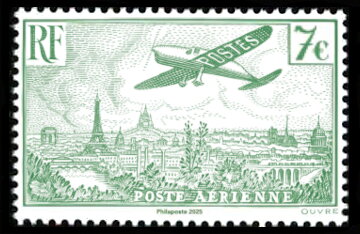Stamp: Aircraft over Paris Design of 1936 (France 2025)
Aircraft over Paris Design of 1936 (France 2025)
27 March (France ) within release Aircraft over Paris Design of 1936 goes into circulation Stamp Aircraft over Paris Design of 1936 face value 7 Euro
| Stamp Aircraft over Paris Design of 1936 in catalogues | |
|---|---|
| Colnect codes: | Col: FR 2025.03.27-01 |
Stamp is horizontal format.
Issued in panes of fourAlso in the issue Aircraft over Paris Design of 1936:
- Stamp - Aircraft over Paris Design of 1936 face value 7;
- Souvenir Sheet - Aircraft over Paris Design of 1936 face value 4*7;
Stamp Aircraft over Paris Design of 1936 it reflects the thematic directions:
An aircraft (pl. aircraft) is a vehicle that is able to fly by gaining support from the air. It counters the force of gravity by using either static lift or the dynamic lift of an airfoil, or, in a few cases, direct downward thrust from its engines. Common examples of aircraft include airplanes, rotorcraft (including helicopters), airships (including blimps), gliders, paramotors, and hot air balloons.Part 1 (Definitions and Abbreviations) of Subchapter A of Chapter I of Title 14 of the U. S. Code of Federal Regulations states that aircraft "means a device that is used or intended to be used for flight in the air."
Aviation is the practical aspect or art of aeronautics, being the design, development, production, operation and use of aircraft, especially heavier than air aircraft. The word aviation was coined by French writer and former naval officer Gabriel La Landelle in 1863, from the verb avier (synonymous flying), itself derived from the Latin word avis ("bird") and the suffix -ation.
A bridge is a structure built to span physical obstacles without closing the way underneath such as a body of water, valley, or road, for the purpose of providing passage over the obstacle. There are many different designs that each serve a particular purpose and apply to different situations. Designs of bridges vary depending on the function of the bridge, the nature of the terrain where the bridge is constructed and anchored, the material used to make it, and the funds available to build it.
A tower is a tall structure, taller than it is wide, often by a significant factor. Towers are distinguished from masts by their lack of guy-wires and are therefore, along with tall buildings, self-supporting structures.




